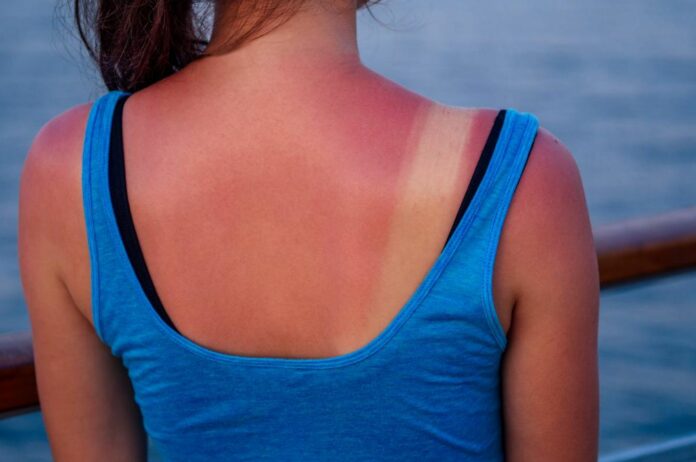The secret to preventing sunburn is not what you think…
People adore the warmth of the sun, yet they often become overheated. Perspiration begins to trickle into their eyes. They then have to engage in various safety measures, like applying sunblock, wearing hats, or putting on sunglasses.
If they expose themselves excessively to the sun or neglect to take adequate preventative steps, their skin protests with a fiery sunburn.
The Sun Can Burn Us Even In The Shade
The Sun is a potent source of various types of radiation, a plethora of which remain invisible to the naked eye as they belong to wavelengths beyond our perceptual range. Ultraviolet (UV) light, emitted with wavelengths just beyond the violet end of the visible spectrum, is one such radiation. Its omnipresence is felt particularly when we are under intense sunlight.
There are three categories of ultraviolet radiation: UV-A which only has superficial effects and does not harm the epidermis or pigment; UV-B which penetrates deeper and is the culprit behind sunburns and the potential development of melanoma; and UV-C which is associated with the depletion of the ozone layer and is fortunately blocked by it.
UV-B radiation also has a role in triggering the production of melanin, the pigment that gives our skin its tan, by stimulating melanocytes.
The skin cells are damaged by ultraviolet light, and in response, our body’s immune system boosts blood circulation to the affected region causing inflammation, or what is commonly known as sunburn.
Protective Measures Against the Sun The World Health Organization advises minimizing sun exposure between 11:00 am and 3:00 pm, and using sunscreens, appropriate clothing, and shade as shields against the sun. But, even with these precautions, there remains a risk of getting burnt.
It’s a known fact that the sun has the potential to cause burns even during overcast days and that various fabrics offer different levels of protection. Fabrics with looser weaves like linen shirts don’t guard our skin as effectively as densely woven ones, such as thick cotton T-shirts. Typically, a regular T-shirt provides protection that is less than that of sunscreen with an SPF 15.
The color of the fabric also plays a significant role, with lighter hues like white and beige being less effective compared to darker shades like black or navy blue. The market has recently seen an influx of apparel and umbrellas that come with a specified protection index, ensuring enhanced protection against solar radiation.
Shade vs. SPF sunscreen?
However, it’s important to note that UV light has the ability to reflect off surfaces such as water or snow. This means that merely being under an umbrella doesn’t guarantee full protection.
The percentage of UV light reflected varies depending on the surface – for instance, asphalt reflects about 2%, while sand or snow can reflect about 17% and 85% respectively.
A study conducted by the Langone Medical Center in New York a few years back aimed to measure the risk of sun exposure by comparing people who took refuge under a beach umbrella with those who applied sunscreen.
The study revealed that a staggering 78% of the participants who stayed under the umbrella shade suffered from sunburn, as opposed to 25% of those who used sunscreen with a high SPF.
Can High SPF Sunscreen (SPF 50+ or SPF 100+) protect us from sunburn?
A recently published study in the Journal of the American Academy of Dermatology reveals that SPF 100+ is notably more potent in safeguarding against sunburns compared to SPF 50+ (indeed, this remains an issue even on chilly, yet sunny winter days!).
In this research, which was a collaboration between scientists at Neutrogena® and Darrell S. Rigel, M.D., who is a Clinical Professor of Dermatology at NYU Langone Medical Center, approximately 200 participants with diverse skin tones were provided with two sunblock products with distinct SPF levels (50+ and 100+). They were instructed to apply each lotion to one-half of their face during a day of skiing and snowboarding under the sun in Vail, Colorado.
The findings? Post roughly six hours of exposure to the sun, over half of the participants, exhibited more sunburn on the facial region where they had applied an SPF 50+ sunscreen. This contrasted sharply with a mere 5% who had a greater degree of sunburn on the side where they had used the SPF 100+ sunscreen.
Furthermore, it wasn’t due to how the individuals applied the sunscreens: Similar amounts were used and reapplied with both products, according to the researchers.
These findings are consistent with the fact that SPF 50 sunscreens enable twice as many harmful UV rays to penetrate the skin than SPF 100 sunscreens.
In summary, it’s imperative to understand that while it’s impossible to completely eliminate the risk of sunburn, employing a combination of protective strategies can significantly mitigate it.
Image Credit: Getty
